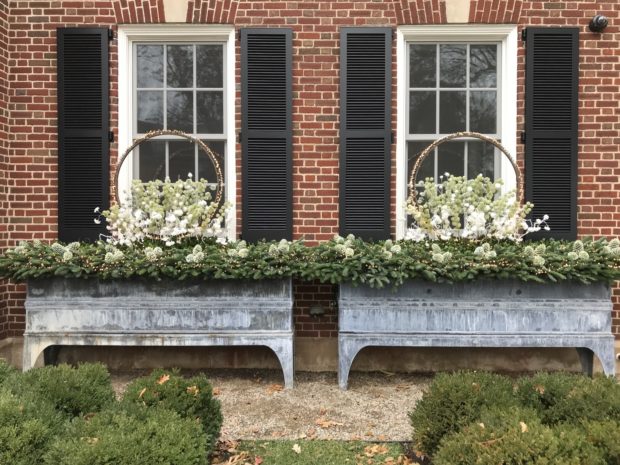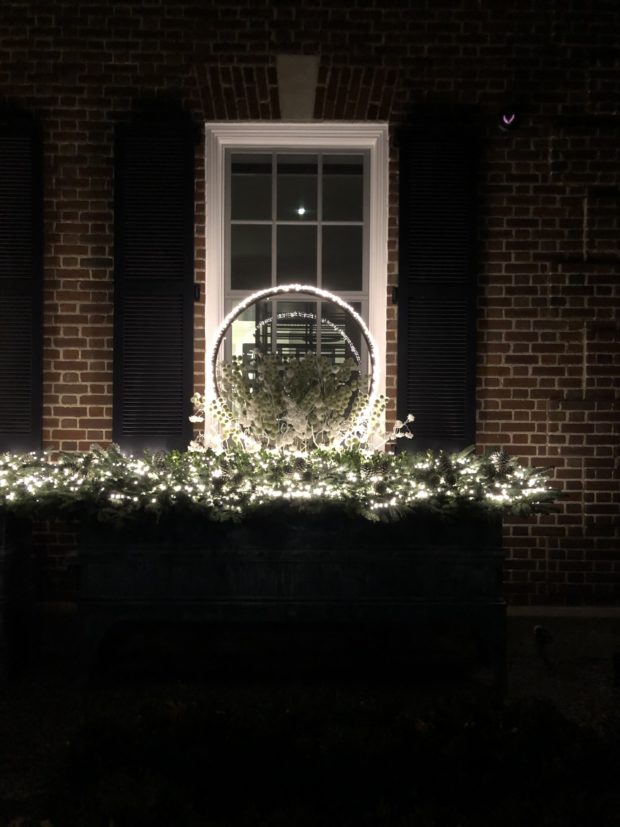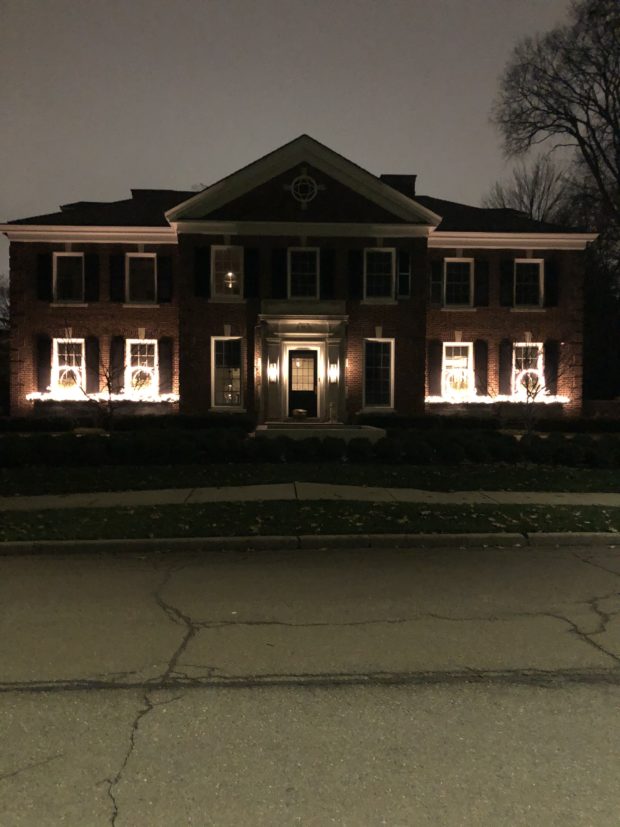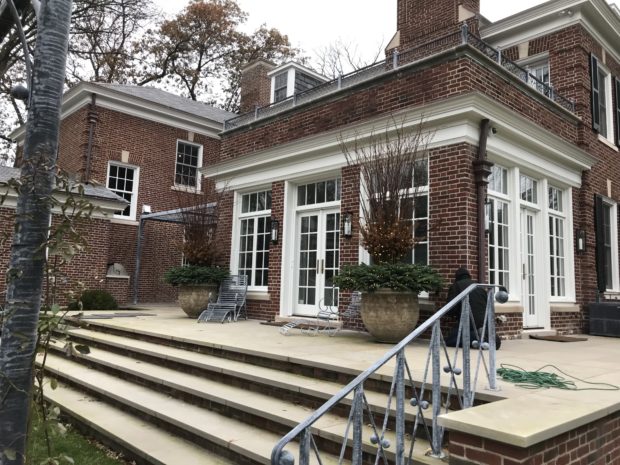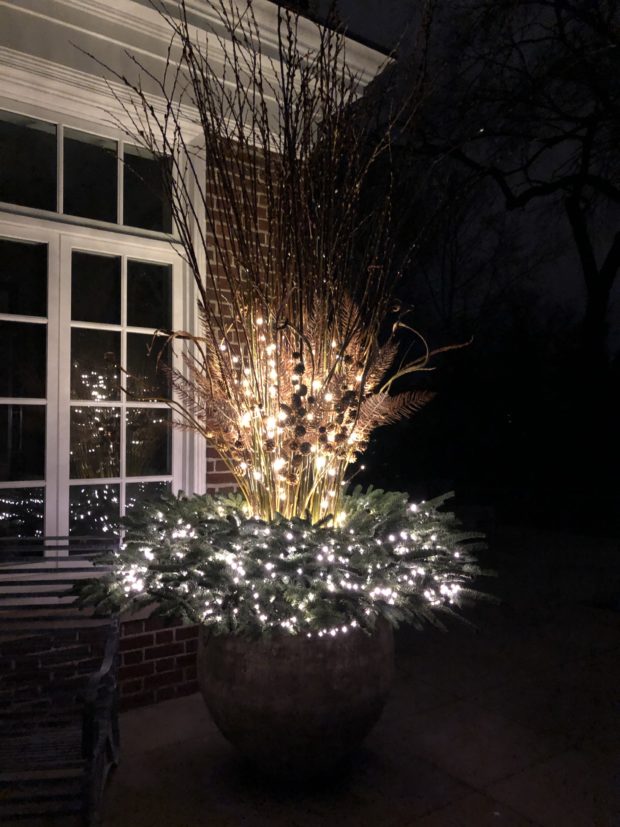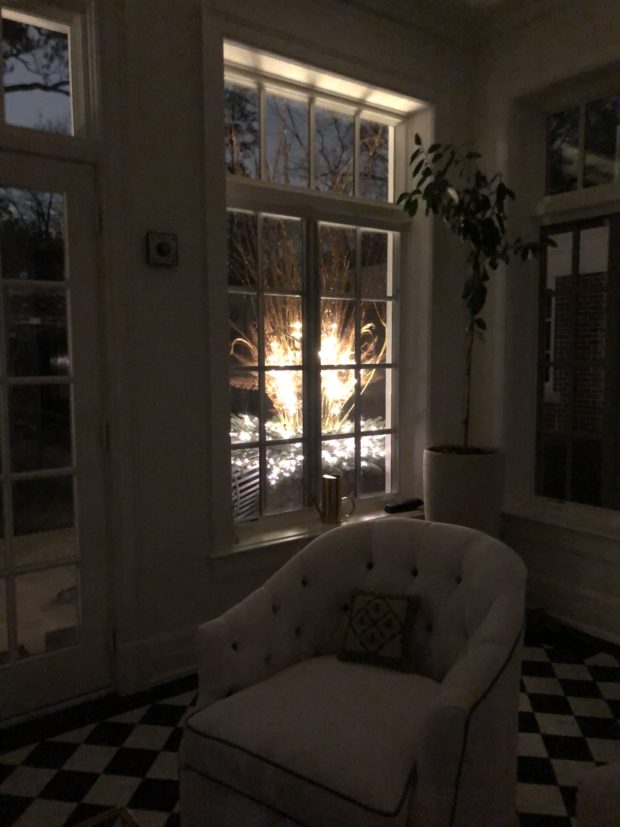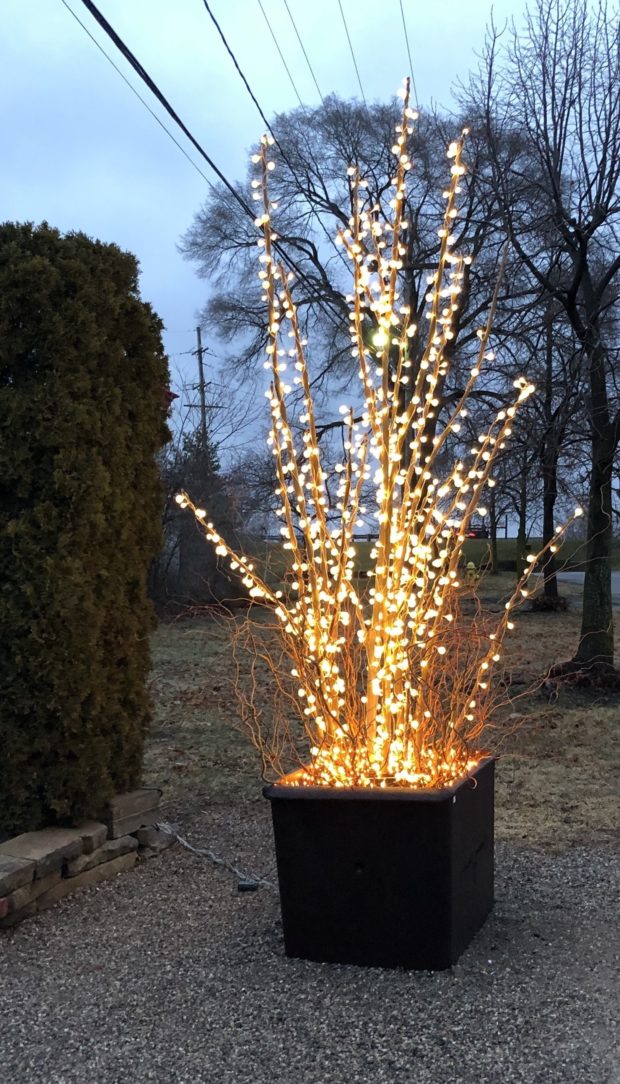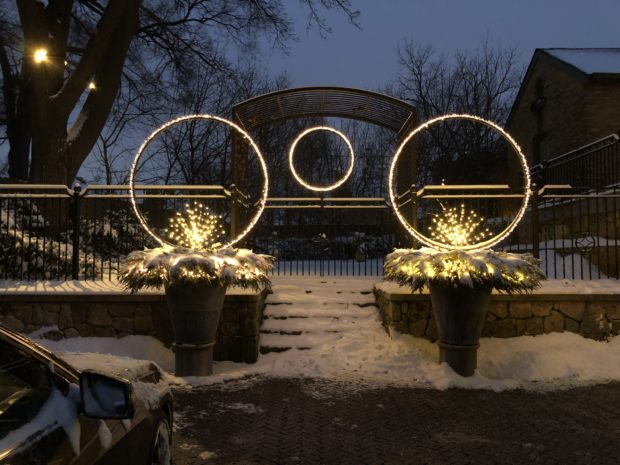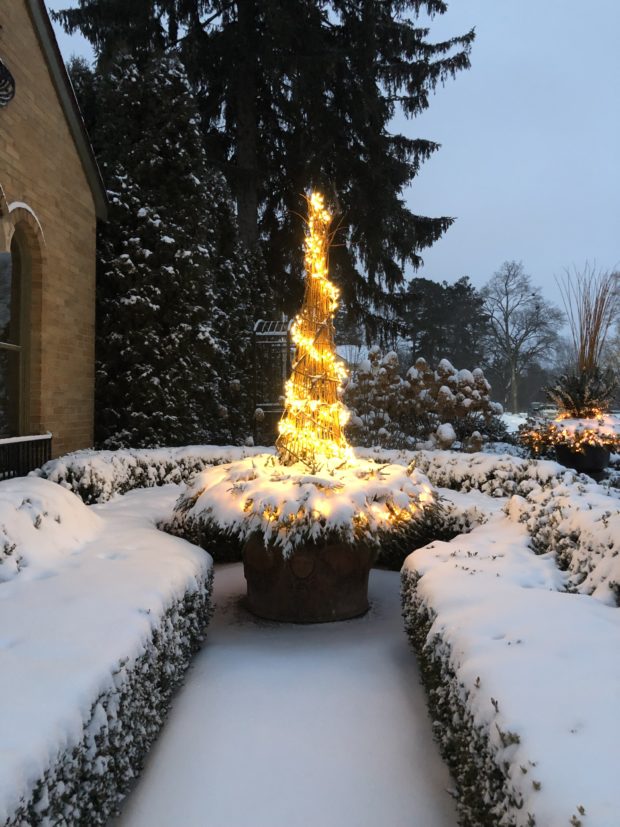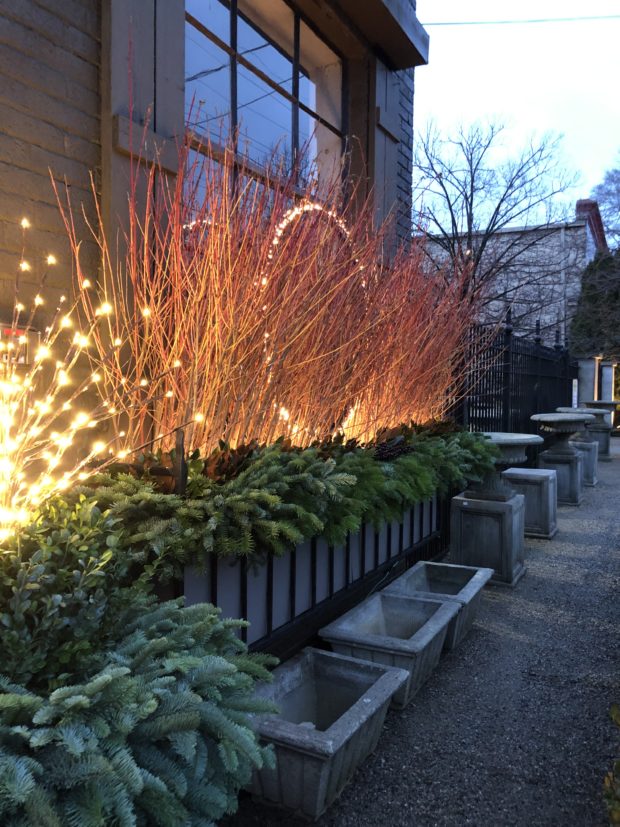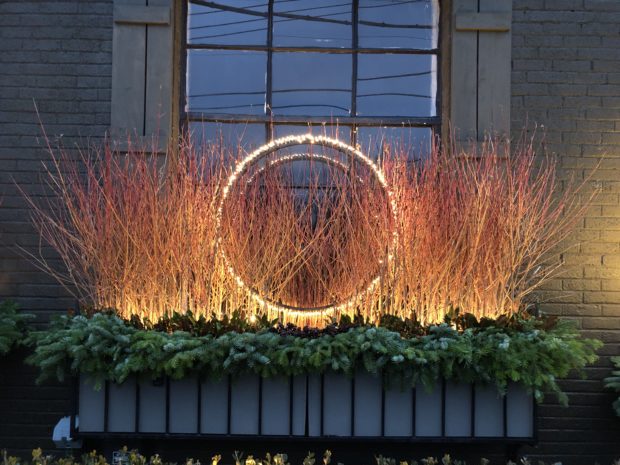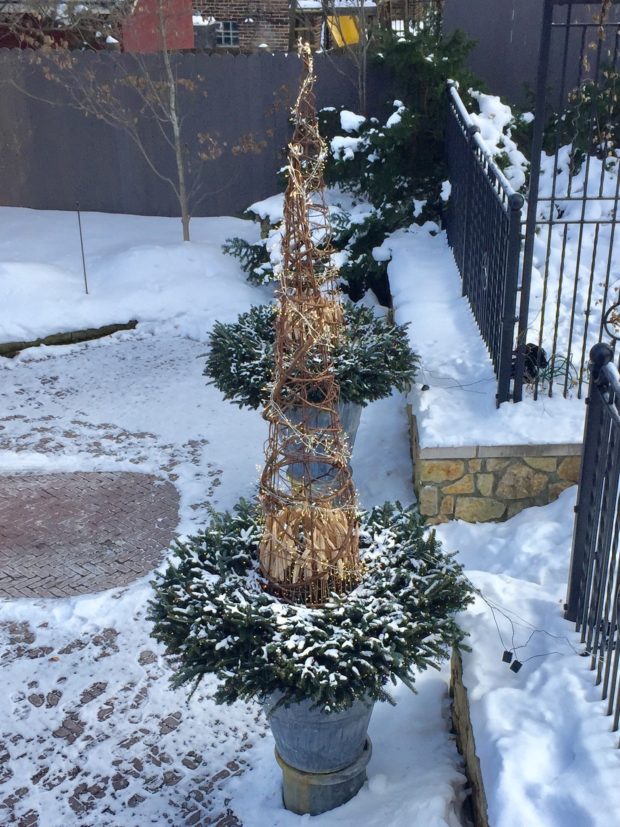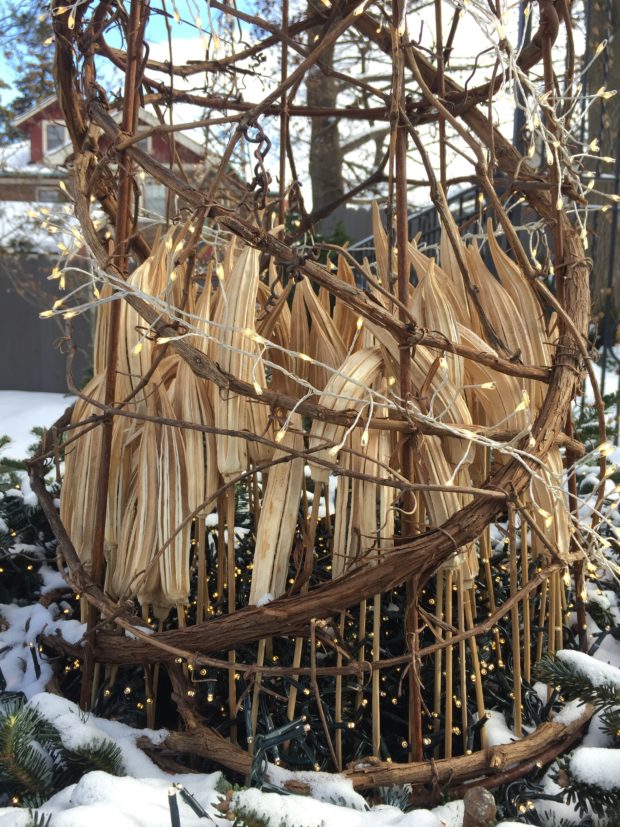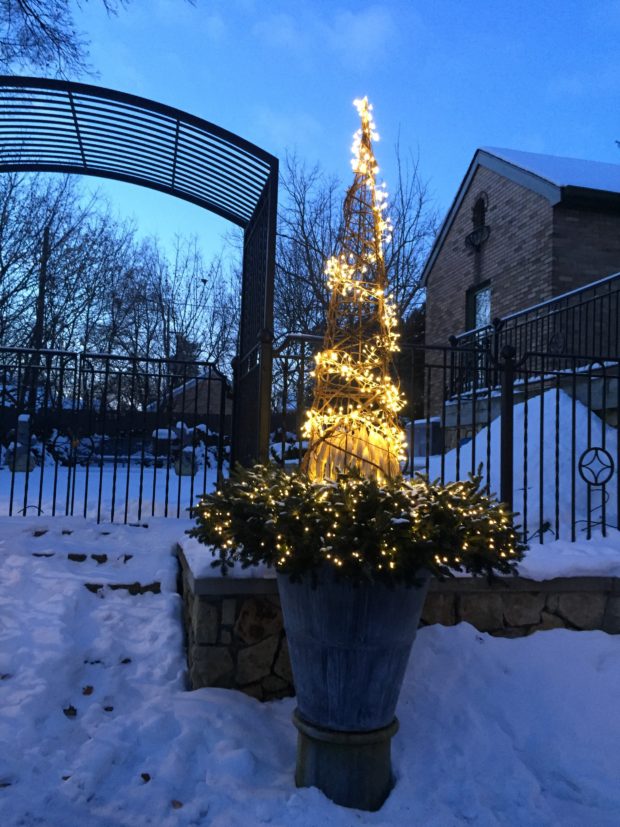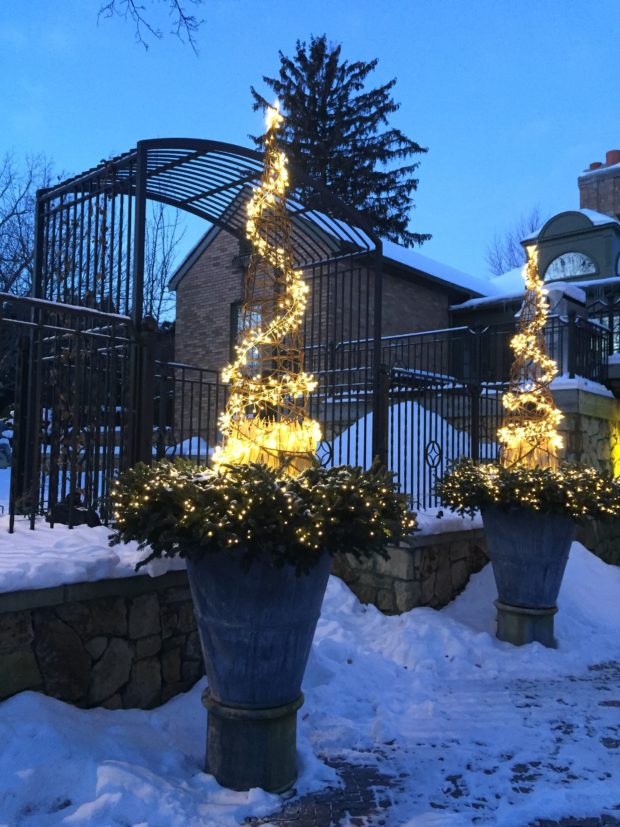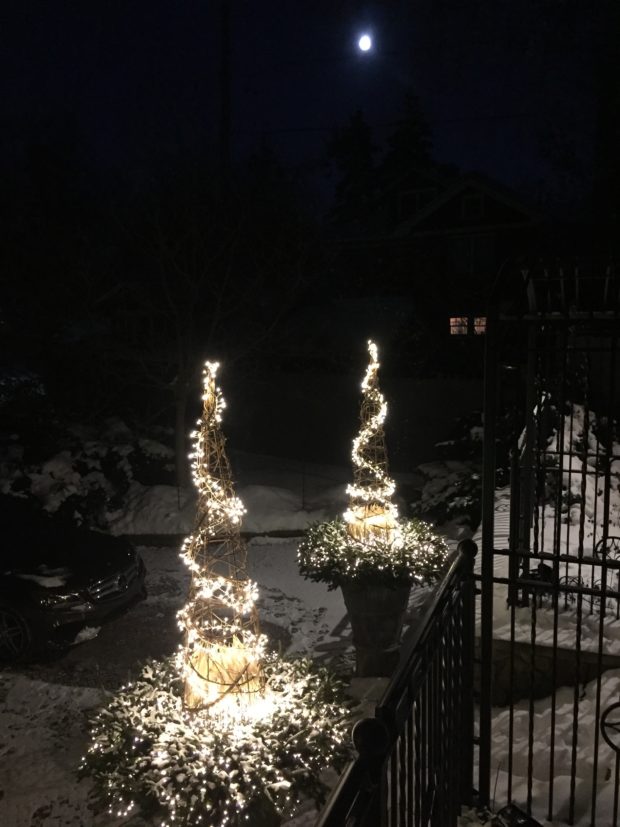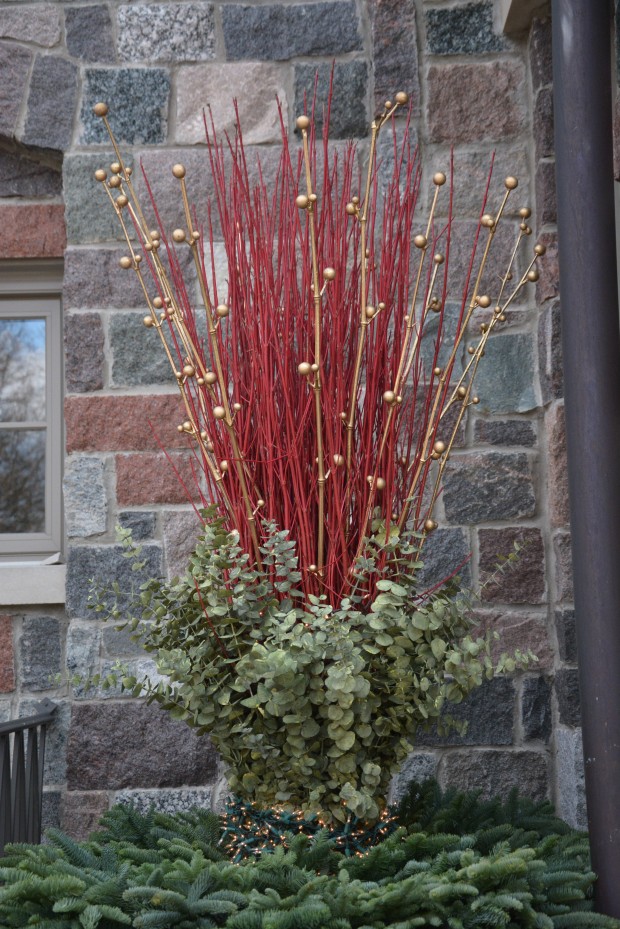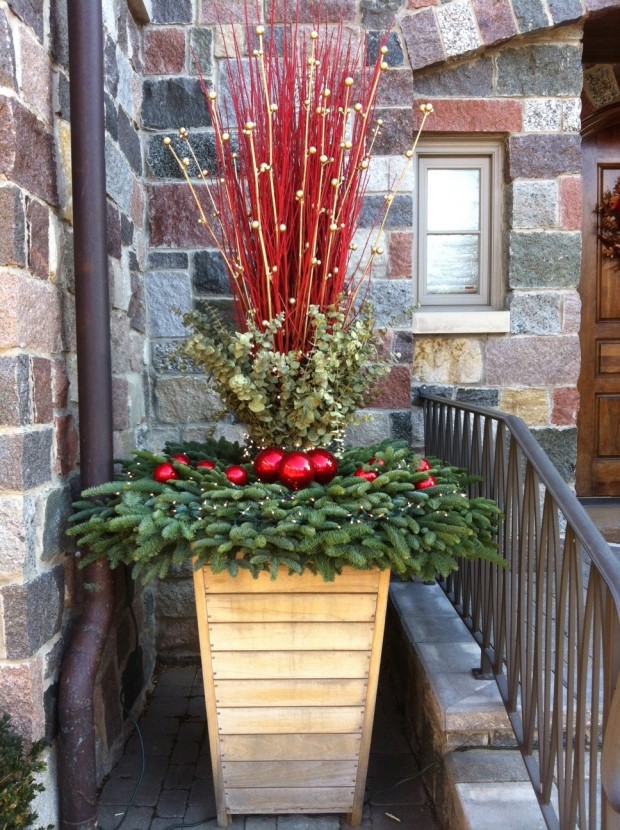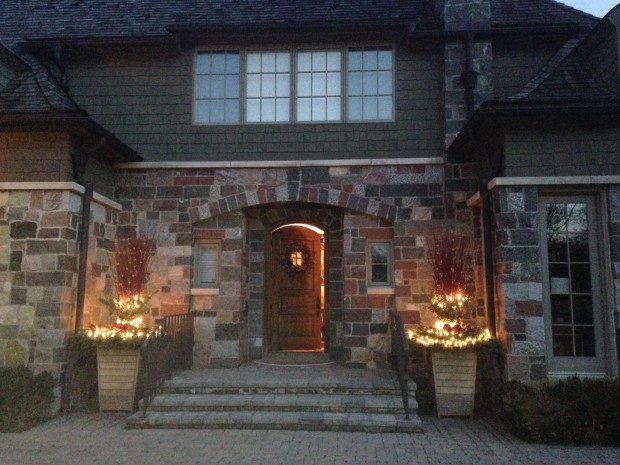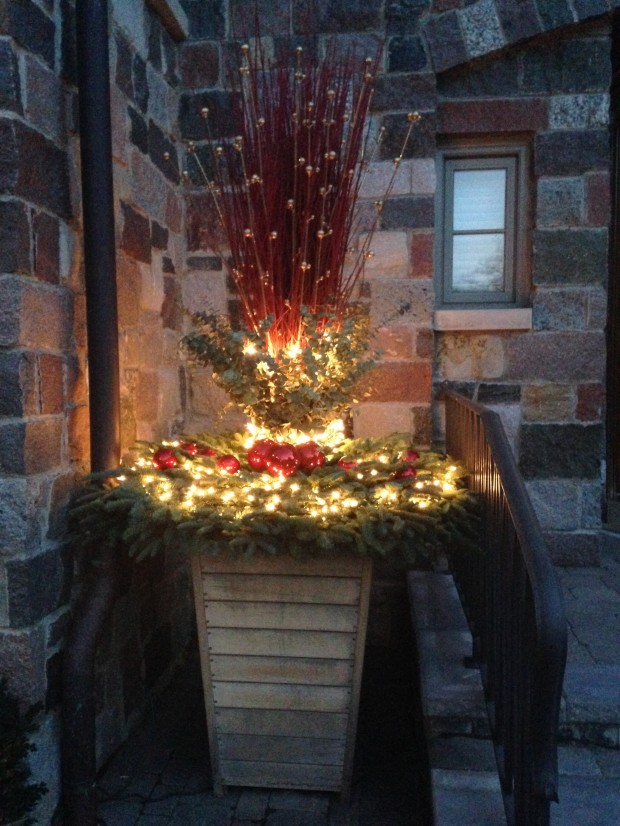 We designed and installed the landscape here in 2015, part of which included a large blue stone landing linking the driveway to the front door. I always appreciate the opportunity to design the hard surfaces at the front door. Too often the walk and porch are too narrow, and any steps too shallow. The front door certainly asks to be a focal point of a home. That generously paved space made it possible to place a quartet of good sized steel planter boxes from Branch in concert with the door. The pots get planted in the spring, and are updated for all of the seasons to come. The winter is perhaps the most dramatic of all, as it should be. The Michigan winter is very long. The days are short and gray, and the nights come early and are black dark. Rob’s lighted steel tree forms on rod steel legs were installed directly into the pots – a request from my intrepid clients. A pair of seven footers in the back pair, and a pair of five footers in the front do an astonishingly good job of introducing light into the winter airspace. The resulting glow is warm and atmospheric. The lighting in the containers accomplishes something that traditional landscape lighting rarely does. It creates an opportunity for theater in the landscape.
We designed and installed the landscape here in 2015, part of which included a large blue stone landing linking the driveway to the front door. I always appreciate the opportunity to design the hard surfaces at the front door. Too often the walk and porch are too narrow, and any steps too shallow. The front door certainly asks to be a focal point of a home. That generously paved space made it possible to place a quartet of good sized steel planter boxes from Branch in concert with the door. The pots get planted in the spring, and are updated for all of the seasons to come. The winter is perhaps the most dramatic of all, as it should be. The Michigan winter is very long. The days are short and gray, and the nights come early and are black dark. Rob’s lighted steel tree forms on rod steel legs were installed directly into the pots – a request from my intrepid clients. A pair of seven footers in the back pair, and a pair of five footers in the front do an astonishingly good job of introducing light into the winter airspace. The resulting glow is warm and atmospheric. The lighting in the containers accomplishes something that traditional landscape lighting rarely does. It creates an opportunity for theater in the landscape.
 Is theater a good quality in a landscape? Of course. Divine theater is created in the landscape by nature in countless unanticipated ways. That theater is what gives rise to those perfect moments in the garden. An unforgettable moment that will probably never be repeated is what gardeners garden towards. That is landscape theater at its best. Every gardener has their own version of that experience. Pictured above is a property that had major regrading and a new driveway last year. The landscape would have to wait until spring, as would the landscape lighting. As a temporary measure, we wrapped galvanized pipe with LED string lights. The pipes were threaded over steel rebar that had been sunk deep in the ground. The lighted pipes were not fancy, but the repetition of them on a wide sweeping curve was ruggedly sculptural. And they lit the driveway enough for a walk to the mailbox for the morning paper. Contemporary lighted landscape bollards from Louis Poulsen are due to be installed this month. They will light the way in a much more formal way. They are a permanent lighting solution that will be more about function than theater.
Is theater a good quality in a landscape? Of course. Divine theater is created in the landscape by nature in countless unanticipated ways. That theater is what gives rise to those perfect moments in the garden. An unforgettable moment that will probably never be repeated is what gardeners garden towards. That is landscape theater at its best. Every gardener has their own version of that experience. Pictured above is a property that had major regrading and a new driveway last year. The landscape would have to wait until spring, as would the landscape lighting. As a temporary measure, we wrapped galvanized pipe with LED string lights. The pipes were threaded over steel rebar that had been sunk deep in the ground. The lighted pipes were not fancy, but the repetition of them on a wide sweeping curve was ruggedly sculptural. And they lit the driveway enough for a walk to the mailbox for the morning paper. Contemporary lighted landscape bollards from Louis Poulsen are due to be installed this month. They will light the way in a much more formal way. They are a permanent lighting solution that will be more about function than theater.
 There came a time when Howard was of an age that he could not navigate the steep steps going down into the garden from the deck. Lighting those steps with landscape lighting would certainly have helped me find my way up and down. But it would have been of no use to him, or our relationship. The lighting from the container pictured above made it possible for him to see me in the garden, and for me to see him. I had no worry that he would attempt the stairs, as he could see me. This moment was certainly theater. It told a story. I have this picture, and a very good memory.
There came a time when Howard was of an age that he could not navigate the steep steps going down into the garden from the deck. Lighting those steps with landscape lighting would certainly have helped me find my way up and down. But it would have been of no use to him, or our relationship. The lighting from the container pictured above made it possible for him to see me in the garden, and for me to see him. I had no worry that he would attempt the stairs, as he could see me. This moment was certainly theater. It told a story. I have this picture, and a very good memory.
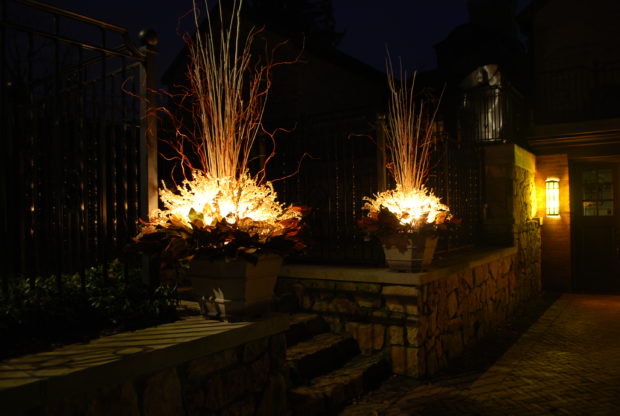 No doubt these lighted containers at the end of the driveway are handy for illuminating the car door handle in the early morning, and a welcome home at night. There is a landscape down light in a nearby tree that no doubt makes the area easier to see at night, but the pots on the wall loaded with strings of lights at the base are more cheery and inviting than instructive. Landscape lighting that features specific objects or places in the landscape dictates the scope of the interaction. Designing and placing seasonal lighting in containers is a kind of gardening. They are as much celebration of the time as they are a reaction to it. It can organize a space or frame even a dimly lit view. They are a reason to view and visit the garden, despite the dark, cold and snow.
No doubt these lighted containers at the end of the driveway are handy for illuminating the car door handle in the early morning, and a welcome home at night. There is a landscape down light in a nearby tree that no doubt makes the area easier to see at night, but the pots on the wall loaded with strings of lights at the base are more cheery and inviting than instructive. Landscape lighting that features specific objects or places in the landscape dictates the scope of the interaction. Designing and placing seasonal lighting in containers is a kind of gardening. They are as much celebration of the time as they are a reaction to it. It can organize a space or frame even a dimly lit view. They are a reason to view and visit the garden, despite the dark, cold and snow.
 As the winter season soldiers on, the benefit of lighted winter pots intensifies. The visual interest and comfort they afford is difficult to ignore on a late January afternoon.
As the winter season soldiers on, the benefit of lighted winter pots intensifies. The visual interest and comfort they afford is difficult to ignore on a late January afternoon.
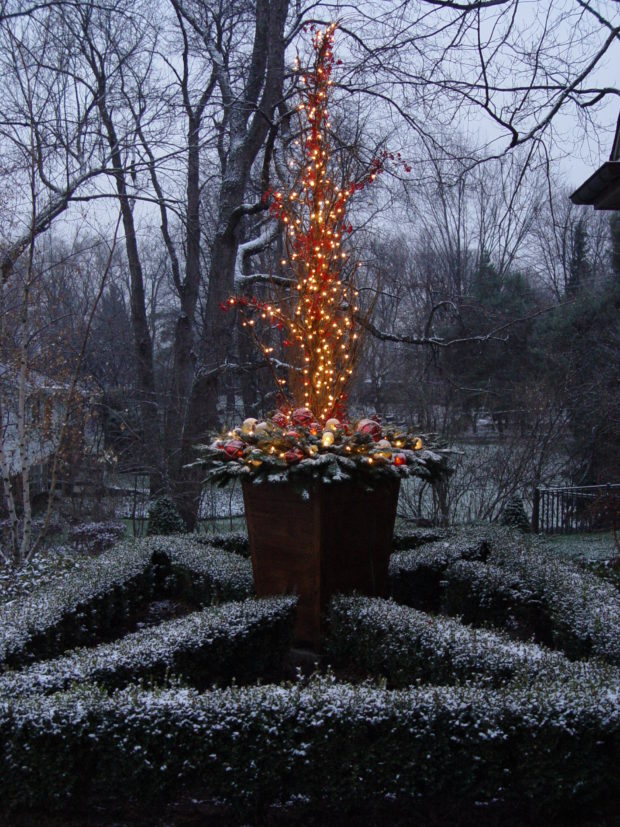 Our first lighted containers were designed specifically to celebrate the holiday season in December. It is a short bridge to cross, taking the concept of holiday decorating outdoors. The above container arrangement certainly draws on that history. But as remarkably different this holiday container is from the surrounding landscape, it is the light that brings the arrangement to life. It was remarkably time consuming to attach strings of lights vertically to a collection of branches. But that light transformed the view. The formal foreground landscape in contrast to the naturally chaotic background is a visual discussion easy to pass by in the winter. The lighted pot gives pause as much as pleasure.
Our first lighted containers were designed specifically to celebrate the holiday season in December. It is a short bridge to cross, taking the concept of holiday decorating outdoors. The above container arrangement certainly draws on that history. But as remarkably different this holiday container is from the surrounding landscape, it is the light that brings the arrangement to life. It was remarkably time consuming to attach strings of lights vertically to a collection of branches. But that light transformed the view. The formal foreground landscape in contrast to the naturally chaotic background is a visual discussion easy to pass by in the winter. The lighted pot gives pause as much as pleasure.
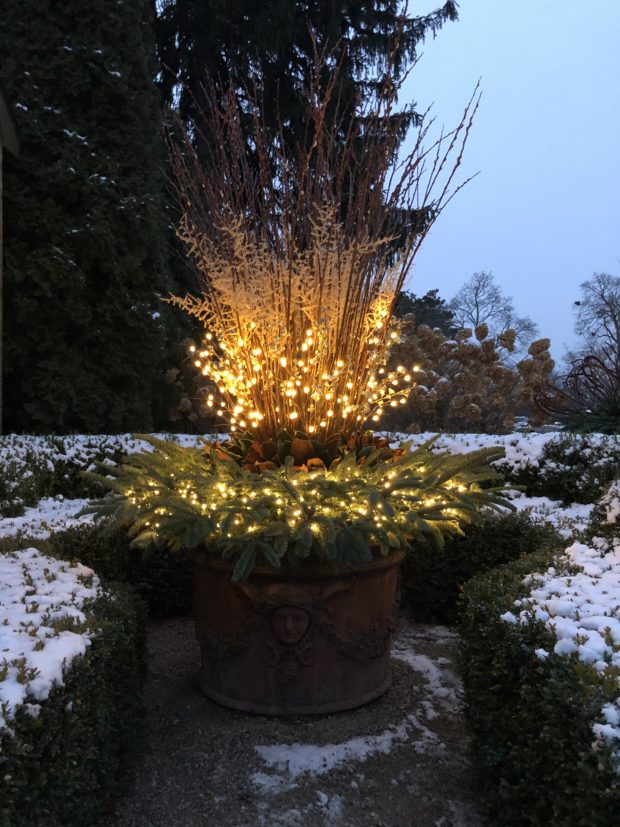 The lighting materials available now are light years ahead of what we worked with 15 years ago in presentation, durability and economy. Most notable is the recent advent of twig lighting of various types and sizes. In any given winter season, Rob will carry 10 or 15 different styles. The come with pointed ends that can be inserted in the soil or a form. The lights are securely affixed to the faux twigs, and the entire assembly is covered in a waxy waterproof material. Embedded in a natural twig centerpiece, the lighted effect is enchantingly simple to achieve, and satisfying to look at. The string lighting typically put in the greens are not especially effective in lighting the centerpiece materials, unless those lights are applied with a very heavy hand. On occasion we will wrap a centerpiece with string lights at the base multiple times. But there is a limit to how far that light will migrate from its source.
The lighting materials available now are light years ahead of what we worked with 15 years ago in presentation, durability and economy. Most notable is the recent advent of twig lighting of various types and sizes. In any given winter season, Rob will carry 10 or 15 different styles. The come with pointed ends that can be inserted in the soil or a form. The lights are securely affixed to the faux twigs, and the entire assembly is covered in a waxy waterproof material. Embedded in a natural twig centerpiece, the lighted effect is enchantingly simple to achieve, and satisfying to look at. The string lighting typically put in the greens are not especially effective in lighting the centerpiece materials, unless those lights are applied with a very heavy hand. On occasion we will wrap a centerpiece with string lights at the base multiple times. But there is a limit to how far that light will migrate from its source.
 There is also a limit to the height of manufactured twig lighting. The lighting technology is certainly there. But shipping an object that is too large or tall to go UPS or FedEx means it has to go freight. Shipping via a freight carrier is very expensive. So certain garden staples-like topiary forms, plant climbers and twig lights are either limited to a shippable height, or come in pieces that have to be put together by the end user. We only ship our full height topiary forms once in a while, as the cost is so great. We really make them for our local clients. So in the container pictured above, Rob hand wound string lights up each branch to get the height he wanted. It was well worth the trouble. These lights can be seen from a long way away. The globe shape of cherry lights is a welcome change from the the typical pinpoint of light of most light strands.
There is also a limit to the height of manufactured twig lighting. The lighting technology is certainly there. But shipping an object that is too large or tall to go UPS or FedEx means it has to go freight. Shipping via a freight carrier is very expensive. So certain garden staples-like topiary forms, plant climbers and twig lights are either limited to a shippable height, or come in pieces that have to be put together by the end user. We only ship our full height topiary forms once in a while, as the cost is so great. We really make them for our local clients. So in the container pictured above, Rob hand wound string lights up each branch to get the height he wanted. It was well worth the trouble. These lights can be seen from a long way away. The globe shape of cherry lights is a welcome change from the the typical pinpoint of light of most light strands.
 This window box at the shop from 2019 stuffed to overflowing with the stems of the dogwood “Midwinter Fire” is handsome during the day, but true to its name at night. Most of the lighting action comes from a pair of 50 foot strands of Lumineo brand garland style string lights sprinkled on the surface. The low cut branches of magnolia obscures the wiring during the day. The lighted ring is a contrasting, precisely geometric shape whose outline is clearly visible at night. This lighted container says nothing about a holiday, but it says everything about the designed winter landscape.
This window box at the shop from 2019 stuffed to overflowing with the stems of the dogwood “Midwinter Fire” is handsome during the day, but true to its name at night. Most of the lighting action comes from a pair of 50 foot strands of Lumineo brand garland style string lights sprinkled on the surface. The low cut branches of magnolia obscures the wiring during the day. The lighted ring is a contrasting, precisely geometric shape whose outline is clearly visible at night. This lighted container says nothing about a holiday, but it says everything about the designed winter landscape.
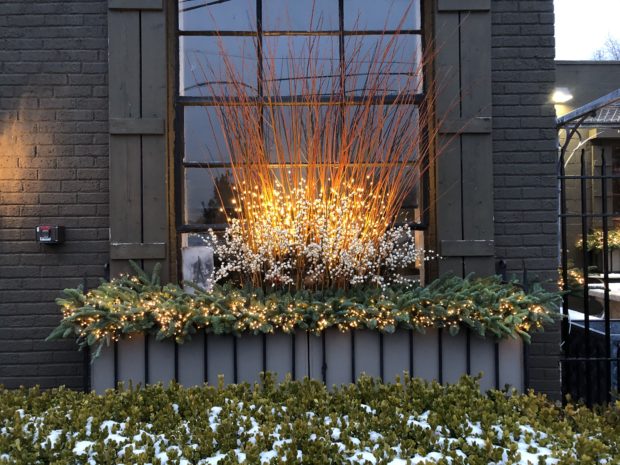 That same box assembled this year features twig lighting placed in the thick of the sticks. Exterior lighting from years ago was so much about the profusion of cords and wires that the daytime look was terrible. One had to spend an inordinate amount of time concealing the works, or choose to celebrate either the day or the night.
That same box assembled this year features twig lighting placed in the thick of the sticks. Exterior lighting from years ago was so much about the profusion of cords and wires that the daytime look was terrible. One had to spend an inordinate amount of time concealing the works, or choose to celebrate either the day or the night.
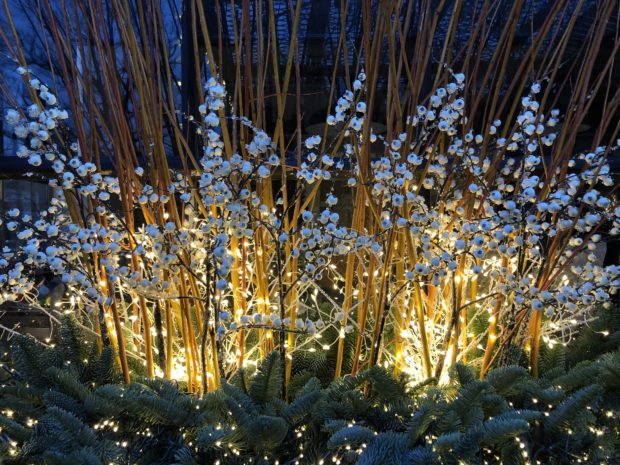 Not much in the way of electrical trappings is apparent here. These twig lights are integral to small white stems, the color of which pairs well with fresh cut twigs of a lighter color. And in this case, faux white berry stems. The walk to my office door will be well lit and visually lively, morning and night, the entire winter.
Not much in the way of electrical trappings is apparent here. These twig lights are integral to small white stems, the color of which pairs well with fresh cut twigs of a lighter color. And in this case, faux white berry stems. The walk to my office door will be well lit and visually lively, morning and night, the entire winter.
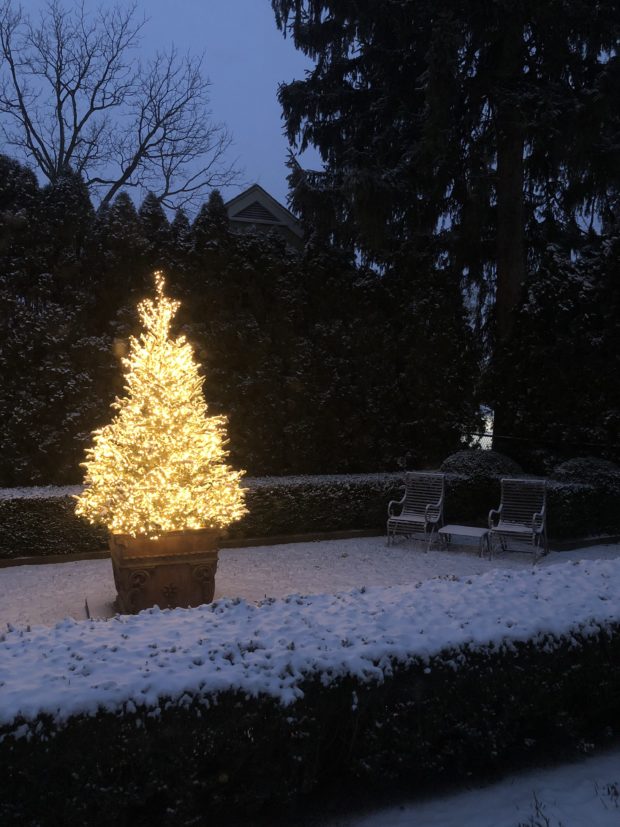 This cut Fraser fir tree in my side yard container is secured with 4 pieces of steel rebar pounded down in to the soil, and galvanized steel guy wires. Given that LED string lighting draws so little in the way of electricity, they can be made in long lengths. Rob carries strands that are over 100 feet long each. This makes lighting a tree much more simple and efficient. This is all the light I will have in my side yard all winter, and it is all the light I need. The tree is visible from every window facing my south side landscape, and from the street as I drive up after work. I will not take it down until the soil in the pot thaws in March.
This cut Fraser fir tree in my side yard container is secured with 4 pieces of steel rebar pounded down in to the soil, and galvanized steel guy wires. Given that LED string lighting draws so little in the way of electricity, they can be made in long lengths. Rob carries strands that are over 100 feet long each. This makes lighting a tree much more simple and efficient. This is all the light I will have in my side yard all winter, and it is all the light I need. The tree is visible from every window facing my south side landscape, and from the street as I drive up after work. I will not take it down until the soil in the pot thaws in March.
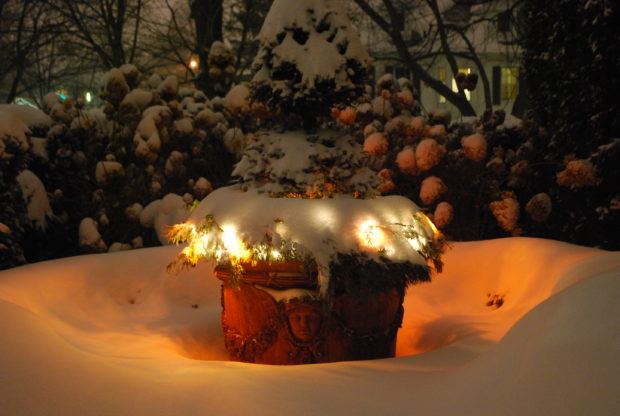 LED lighting produces just about nothing in the way of heat. This means the mountains of snow we are sure to get will glow from the inside, rather than melt. We do indeed take winter container lighting seriously. It is rise and shine worthy.
LED lighting produces just about nothing in the way of heat. This means the mountains of snow we are sure to get will glow from the inside, rather than melt. We do indeed take winter container lighting seriously. It is rise and shine worthy.



